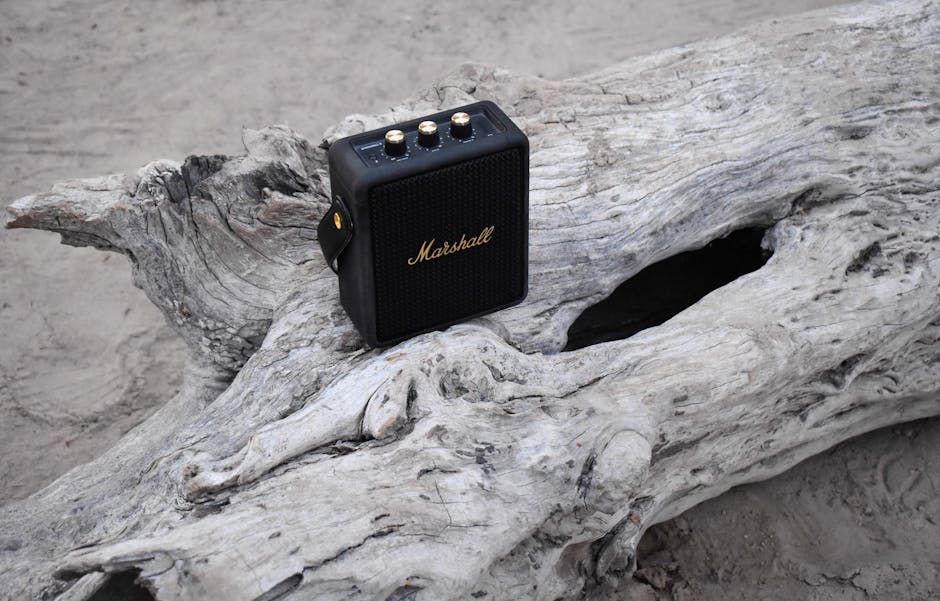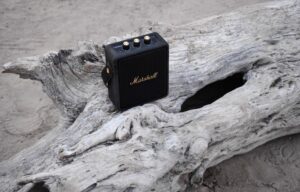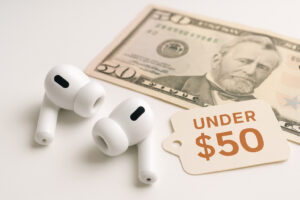Portable Bluetooth Speaker Buying Guide: 10 Best Picks 2025
What to Look for in a Portable Bluetooth Speaker
Looking for a portable bluetooth speaker buying guide? Here’s a quick overview of what matters most:
- Sound Quality – Check power output (15-20 watts for outdoor use) and frequency response (20Hz-20kHz is ideal)
- Battery Life – Aim for 10-30 hours (most average 12-15 hours)
- Durability – Look for IP67 or IP68 rating for water/dust protection
- Size & Weight – Under 2 pounds for true portability
- Connectivity – Bluetooth 5.0+ offers up to 800 feet range
- Price – Quality speakers range from $50-$400 (sweet spot: $100-150)
Wireless freedom has revolutionized how we enjoy music. Whether you’re hosting a backyard barbecue, hitting the beach, or just moving from room to room, a good Bluetooth speaker can transform your listening experience. But with thousands of options ranging from $25 to over $1,000, how do you cut through the noise?
The perfect portable speaker balances sound quality, battery life, durability, and price. Today’s models offer impressive features like 30-hour batteries, full waterproofing, and the ability to pair multiple speakers together. Some can even charge your phone in a pinch.
In this comprehensive guide, we’ll help you understand what specs actually matter, which features are worth paying for, and how to match a speaker to your specific needs without getting lost in technical jargon.

Basic portable bluetooth speaker buying guide glossary:
– Bluetooth speaker for backyard
– Bluetooth speaker portable charger
Why This Guide Matters
If you’ve ever found yourself staring at a wall of speakers in an electronics store or scrolling endlessly through online options, you know the struggle is real. Decision paralysis sets in quickly when faced with dozens of models that all seem to promise the same thing: amazing sound in a portable package.
The truth is, manufacturers love to bombard you with technical jargon and flashy specs that sound impressive but may not translate to real-world performance. We’ve tested countless speakers over the years, and we’re here to cut through the marketing hype with practical, straightforward advice.
This guide isn’t just about understanding the numbers on a spec sheet—it’s about helping you find a speaker that fits your lifestyle, your budget, and your ears. Because at the end of the day, the best speaker is the one that makes your favorite music sound great wherever you want to hear it.
Portable Bluetooth Speaker Buying Guide: Decoding Specifications
When you start shopping for a portable Bluetooth speaker, you’ll quickly run into walls of text filled with numbers, abbreviations, and technical jargon. Don’t worry – you don’t need an engineering degree to make a smart choice! Let’s break down these specs into something that actually makes sense for real-world listening.
Think of specifications as the speaker’s resume – they tell you what it’s capable of, but just like a resume, some claims might be a bit exaggerated. The key is knowing which numbers actually matter for your listening experience.
Most humans can hear sounds between 20 Hz and 20 kHz (that’s the low bass rumble to the highest shimmer), though smaller speakers often struggle with those deep bass notes below 80 Hz, no matter what the box claims. And while a speaker might technically work at maximum volume, most sound their best at around 80-90% of their top volume before distortion creeps in.
What Power & Frequency Numbers Really Mean – portable bluetooth speaker buying guide
Power Output (Watts) tells you how loud a speaker can get, but bigger isn’t always better. For personal listening or a small bedroom, 5-10 watts is plenty. Planning beach trips or backyard gatherings? Look for 15-20 watts. Need to fill larger spaces or outdoor areas? Aim for 20+ watts.
Here’s an insider tip: look for the RMS (Root Mean Square) power rating rather than peak power. RMS represents what the speaker can consistently deliver without distortion – it’s the honest number. Unfortunately, many brands only advertise the more impressive-sounding peak power.
Sensitivity might be the most underrated spec on the list. Measured in decibels (dB), it shows how efficiently a speaker converts power into sound. A higher sensitivity (above 90 dB) means your speaker gets louder using less battery power – a win-win for portable use!
As for Frequency Response, those numbers (like 20 Hz–20 kHz) tell you the range from lowest bass to highest treble the speaker can produce. Be skeptical when tiny speakers claim deep bass – physics simply doesn’t allow a small driver to move enough air for those floor-rumbling lows.

Want to really understand what these audio specs mean for your listening experience? Check out our deep dive on Understanding Audio Specs.
Bluetooth Versions & Codecs – portable bluetooth speaker buying guide
When it comes to Bluetooth versions, newer is definitely better. The jump from Bluetooth 4.2 to 5.0 was like upgrading from a bicycle to a motorcycle – dramatically improved range (up to 800 feet in open spaces versus just 33 feet), faster data speeds, and much more stable connections.
Most current devices feature Bluetooth 5.0 or newer (we’re up to 5.3 now), which works perfectly with older devices but performs best when paired with other modern Bluetooth equipment.
Audio codecs are like languages your devices use to talk to each other. The basic codec everyone speaks is SBC – it’s universal but not particularly impressive. Higher-quality codecs like AAC (especially good with Apple devices), aptX/aptX HD, and Sony’s LDAC deliver noticeably better sound with less compression.
Here’s the catch – both your speaker and your phone/tablet need to speak the same “language.” If your phone supports aptX but your speaker doesn’t, they’ll default back to SBC. When shopping, match the codec support to the devices you already own.
The newest kid on the Bluetooth block is Auracast – think of it like turning your speaker into a mini radio station that multiple people can tune into simultaneously. It’s perfect for public viewing parties or sharing music in group settings. The technology is still rolling out, but it’s worth keeping an eye on. You can learn more about Auracast broadcast technology if you’re curious about the future of shared listening.
If you plan to use your speaker while watching videos or gaming, pay attention to latency – that annoying delay between seeing something happen on screen and hearing the sound. Look for speakers advertising “low latency mode” (under 100ms) to keep everything in sync.
Battery Life & Charging Options
A dead speaker is just an expensive paperweight, so battery performance matters enormously. Most manufacturers list the maximum playback time based on moderate volume (around 50-60%). Crank it up to maximum, and you’ll likely get about half the advertised battery life.
Battery capacity is measured in milliampere-hours (mAh), with higher numbers generally indicating longer runtime. However, power efficiency varies wildly between models – two speakers with identical mAh ratings might have very different real-world battery life.
Today’s portable bluetooth speaker buying guide wouldn’t be complete without talking about charging options. Most speakers take 2-4 hours to fully recharge, but many now offer quick-charge features that provide several hours of playback after just 15-20 minutes of charging – perfect for those “oops, I forgot to charge it” moments before heading out.
USB-C fast charging has thankfully become standard on most modern speakers, replacing the finicky micro-USB ports of yesteryear. This means faster charging and compatibility with the cables you probably already use for your other devices.
Some clever speakers pull double-duty with power bank functionality, allowing you to charge your phone or tablet in a pinch. While this will reduce the speaker’s own runtime, it can be a lifesaver during outdoor trips or power outages.
For the true outdoor enthusiasts, a few rugged models even incorporate solar charging panels. Don’t expect to fully recharge quickly with these – they’re more for extending battery life during multi-day trips away from power outlets.

Water & Dust Resistance (IP Ratings)
Planning to use your speaker poolside, at the beach, or even in the shower? Then understanding IP (Ingress Protection) ratings is non-negotiable. These two-digit codes tell you exactly how well your speaker handles water and dust.
The first digit rates dust protection:
– 5 means mostly dustproof (some dust might enter but won’t harm functionality)
– 6 means completely dustproof (nothing’s getting in there)
The second digit indicates water resistance:
– 4 (as in IPX4) means splash-resistant from any direction – good for light rain or shower use
– 7 (as in IP67) means it can survive accidental submersion in up to 1 meter of water for 30 minutes
– 8 (as in IP68) is the gold standard – can handle deeper water (usually up to 1.5 meters) for 30 minutes
For beach trips and pool parties, look for at least IP67 protection. Some waterproof speakers even float, which is incredibly handy for pool use. Just remember that even floating speakers won’t sound great while floating – the drivers need to be above water to work properly.
One crucial detail: water resistance only works when all port covers are properly sealed. Those rubber flaps covering charging ports and aux inputs must be closed to maintain water protection. One forgotten flap can mean a waterlogged speaker!

Understanding these specifications will help you cut through marketing hype and find a speaker that actually delivers what you need. The best speaker isn’t necessarily the one with the most impressive numbers – it’s the one that fits your lifestyle, budget, and sounds great to your ears.
Design, Durability & Portability
When you’re shopping for a speaker that travels with you, its physical design matters just as much as how it sounds. There’s always that balancing act – bigger speakers generally sound better because they can move more air (hello, bass!), but they’re also heavier and take up precious bag space.
Build Quality & Materials
Ever picked up a speaker and just knew it was well-made? The materials tell you a lot about durability and even sound quality:
Most budget speakers come wrapped in plastic enclosures – they’re lightweight on your wallet and in your hand, but they’re more likely to crack if dropped. They can also create unwanted vibrations that color your sound.
Better speakers often feature rubber bumpers that act like little shock absorbers when your speaker takes an inevitable tumble. These grippy surfaces also keep your speaker from sliding off smooth surfaces – super handy on boats or poolside tables!
Premium models typically incorporate metal grills and frames, usually aluminum or steel. Beyond looking sleek, these protect the delicate drivers inside and help dissipate heat when you’re blasting tunes for hours.
For all those buttons and port covers, silicone is the material of choice. It stays flexible whether you’re in the desert heat or winter chill, and creates those crucial watertight seals that keep moisture out.
If sustainability matters to you, look for speakers using eco-friendly materials like bamboo accents, recycled plastics, or biodegradable components. These can add unique character to your speaker while reducing its environmental footprint.
A quality speaker should feel solid in your hand – no rattling when you shake it gently, and buttons that give satisfying feedback when pressed. If it’s meant for outdoor trips, those controls should be large enough to operate even with wet fingers.
Size & Weight Trade-Offs
Portable speakers generally fall into a few distinct weight classes:
Ultra-Compact Contenders (Under 1 lb): These pocket-sized wonders like the JBL Go 3 (0.4 lbs) sacrifice some sound quality and battery life to be incredibly travel-friendly. They’re perfect companions for hiking trails, bike baskets, or when your carry-on is already pushing weight limits.
Everyday Carriers (1-2 lbs): This sweet spot includes popular models like the JBL Flip 6 (1.2 lbs) and Bose SoundLink Flex (1.3 lbs). They strike that perfect balance – good enough sound to enjoy your music properly while still slipping easily into a backpack or large purse without weighing you down.
Weekend Warriors (2-4 lbs): Speakers in this range, like the JBL Charge 5 (2.1 lbs), deliver noticeably better sound with actual bass response. They’re still manageable for day trips, especially since many include carrying straps or built-in handles.
Party Beasts (5+ lbs): When sound quality trumps portability, these larger units like the UE Hyperboom (13 lbs) deliver room-filling sound that smaller speakers simply can’t match. They’re best for occasions when you’re driving to your destination rather than hiking in.
Think about how you’ll actually carry your speaker. Many newer models include clever built-in carabiners, straps, or handles that make transportation easier. Some compact speakers even offer bike mounts or attachment points for securing to backpacks – perfect for trips on two wheels.
Durability Checklist
Beyond those important IP ratings for water and dust protection, consider these durability factors:
How clumsy are you? Some manufacturers specify drop test heights (typically 3-5 feet). Those rubber bumpers and reinforced corners aren’t just for show – they help your speaker survive accidental falls onto hard surfaces.
Will your speaker face extreme weather? Check the operating temperature range if you’ll be using it in very hot or cold environments. Most speakers handle 32°F to 95°F (0°C to 35°C) just fine, but rugged outdoor models often extend this range considerably.
For speakers that live on the patio or deck, look for UV-resistant materials that won’t fade or degrade after months in direct sunlight. Nothing’s worse than a formerly black speaker that’s now an uneven gray!
The most sustainable speakers offer replaceable parts – particularly batteries or grills that might wear out before the rest of the unit. This can significantly extend your speaker’s useful life and reduce electronic waste.
For speakers specifically designed to weather the elements in your outdoor living space, check out our comprehensive guide to the best Bluetooth speakers for backyard environments.
When it comes to portable bluetooth speaker buying guide essentials, the perfect balance of size, durability and portability depends entirely on how and where you’ll use it most often. A speaker that travels easily and survives your lifestyle will always sound better than a “superior” one that stays home because it’s too bulky or fragile!
Connectivity & Smart Extras
Today’s Bluetooth speakers are smarter than ever, offering features that go well beyond simply playing your favorite tunes. Let’s explore how these extra connectivity options can transform your listening experience from good to great.
Multi-Speaker & Stereo Pairing
Remember when a single speaker was your only option? Those days are long gone! Many modern speakers now let you create your own custom sound system:
Party Mode turns any gathering into an instant celebration by connecting multiple identical speakers to play the same music in perfect sync. Some systems like JBL’s PartyBoost can link up to 100 speakers together—though I’ve yet to meet anyone who’s actually tested this limit (or has that many friends to invite over!).
True Wireless Stereo (TWS) is where the magic really happens. Pair two identical speakers to create dedicated left and right channels, and suddenly your music breathes with a spaciousness that a single speaker simply can’t match. The guitars in your favorite rock song might come from the left while vocals center and drums punch from the right—just as the artist intended.

Just be aware that these features typically work only within the same brand family. Your JBL can’t pair with your friend’s Bose—it’s like trying to make dogs and cats speak the same language. Some brands have also created their own connection systems that offer unique advantages:
Sonos leverages WiFi for higher quality whole-home audio, while Ultimate Ears’ PartyUp feature plays nicely with older UE models (a rarity in the tech world). If you already own a speaker from a particular brand, double-check whether any new model you’re considering will pair with your existing gear.
Voice Assistants & Companion Apps
“Hey Google, play my workout playlist!” If you’ve ever wanted your speaker to double as a helpful assistant, you’re in luck. Many mid-range and premium portable bluetooth speaker models now include built-in support for voice assistants like Amazon Alexa, Google Assistant, or Siri.
These smart speakers can control your music hands-free, answer questions, manage your smart home devices, and more—though they typically need a WiFi connection alongside Bluetooth to work their magic. Just remember that this convenience comes with trade-offs: shorter battery life and the privacy considerations of having always-listening microphones in your space.
Companion apps have also evolved from simple utilities to powerful control centers. Through these brand-specific apps, you can:
Fine-tune your sound with custom EQ settings that let you pump up the bass for parties or improve vocal clarity for podcasts. Some even offer presets for different music genres or listening environments.
Keep your speaker current with firmware updates that fix bugs and occasionally add entirely new features—it’s like getting a free upgrade months after purchase.
Monitor battery status so you’re never caught with a dead speaker at the worst possible moment.
These apps make your speaker more versatile, but don’t pay extra for smart features you’ll never use. Be honest with yourself—if you’ve never used Alexa on your phone, you probably won’t start using it on your speaker either.
Wired & Wireless Alternatives
While Bluetooth dominates the portable speaker world, alternative connections can be lifesavers in certain situations:
The humble auxiliary input (3.5mm) might seem old-school, but this little jack offers two significant advantages: it works with devices that don’t have Bluetooth (like that ancient iPod you still love), and it eliminates the slight audio delay that can make watching videos via Bluetooth frustrating. Think of it as your backup plan when wireless isn’t working.
Wi-Fi connectivity transforms certain speakers from portable party machines into full-fledged home audio components. Wi-Fi offers higher audio quality without Bluetooth compression, longer range throughout your home, and the ability to stream directly from services like Spotify without draining your phone’s battery.
| Feature | Bluetooth | WiFi |
|---|---|---|
| Range | ~33 ft (Bluetooth 4.2) Up to 800 ft (Bluetooth 5.0) |
100-200 ft |
| Audio Quality | Compressed (varies by codec) | Uncompressed possible |
| Battery Impact | Moderate | Higher (when active) |
| Setup Complexity | Simple pairing | Network configuration required |
| Multi-room Support | Limited (proprietary systems) | Excellent (AirPlay, Chromecast, etc.) |
| Internet Requirement | No | Yes |
Some speakers also offer NFC pairing (just tap your phone to connect) or USB audio connections that can improve sound quality when connected to computers. These might seem like minor extras, but they can make your speaker more versatile for years to come.
For a deeper dive into connection options and their impact on sound quality, check out our article on Bluetooth vs Wired Audio.
Budget & Value: What Your Money Buys
Let’s talk money. When it comes to portable Bluetooth speakers, prices range from bargain bin finds to luxury splurges that cost more than some smartphones. But here’s the good news – you don’t need to break the bank to get great sound. Let’s explore what your hard-earned cash actually buys you at different price points.
Under $50
The budget-friendly territory might surprise you with what it offers:
Sound at this price point has come a long way. While you won’t get earth-shaking bass, many affordable speakers deliver clear vocals and decent midrange performance. Most use the basic SBC Bluetooth codec, which is perfectly fine for casual listening.
Build quality is primarily plastic with some rubber elements for basic protection. Battery life typically hovers between 6-10 hours – enough for a day at the beach but not a weekend camping trip. Water resistance is usually limited to IPX4 (splash protection), so be careful around pools.
What you won’t find are fancy extras – expect simple Bluetooth connectivity and maybe an aux input for wired connections. But don’t let that discourage you! Models like the Tribit StormBox Micro punch well above their weight class for personal listening or small gatherings.
$50–$150 Sweet Spot
This is where the magic happens for most listeners. The portable bluetooth speaker buying guide price sweet spot delivers significant upgrades over budget options:
Sound quality takes a major leap forward with actual bass presence, clearer highs, and better volume. Many speakers in this range support improved codecs like AAC or aptX for better wireless audio quality. The difference is immediately noticeable – music sounds fuller and more engaging.
Durability becomes a strength rather than a compromise. Most mid-range speakers feature IP67 water and dust protection, meaning they can handle a dunk in the pool without skipping a beat. Materials feel more premium, with rubberized surfaces and metal grills becoming common.
Battery life extends to 12-20 hours, with some models pushing beyond 24 hours at moderate volumes. USB-C fast charging becomes standard, and some models even double as power banks to rescue your dying phone.
Connectivity improves with Bluetooth 5.0 or better, providing more stable connections and features like stereo pairing between two identical speakers. This price range represents the best value-for-money for most users – significant improvements without the premium price tag.
$150–$400 Premium
At this tier, you’re paying for refinement and quality-of-life improvements:
Audio performance becomes notably more sophisticated with multiple drivers and passive radiators working together to create balanced, room-filling sound. Bass response is stronger and more defined, while highs remain crisp even at higher volumes. Support for hi-res codecs like aptX HD or LDAC means you can enjoy near-lossless wireless audio if your source device supports it.
Smart features become more prevalent, with companion apps offering custom EQ settings to tailor the sound to your preferences. Many premium models integrate voice assistants or connect to your home’s WiFi network for expanded functionality beyond simple Bluetooth.
Battery life consistently exceeds 20 hours, with better power management ensuring the speaker performs well even at higher volumes. Build quality reaches new heights with premium materials, thoughtful design touches, and maximum durability ratings.
Models like the Sonos Roam and JBL Charge 5 exemplify this category – they’re not cheap, but the performance justifies the investment if you’re serious about your portable audio.
$400 Plus Flagship
Welcome to the luxury tier, where engineering meets artistry:
Sound quality approaches what you’d expect from traditional home speakers, with sophisticated driver arrays and advanced digital signal processing creating immersive, detailed soundscapes. These speakers aren’t just loud – they’re precisely tuned to deliver audiophile-grade performance in a portable package.
Build quality becomes a statement piece, featuring premium materials like machined aluminum, genuine leather, or sustainable luxury finishes. These speakers are designed to be displayed proudly, not hidden away.

Forward-thinking features like replaceable batteries and modular designs ensure your investment lasts for years. Extended warranty periods and white-glove customer service round out the premium experience.
The Bang & Olufsen Beosound A1 and Devialet Mania represent this category well – they’re investment pieces for those who refuse to compromise on either sound quality or aesthetic appeal.
Though – price doesn’t always directly correlate with performance in specific situations. A $200 speaker designed specifically for outdoor use might outperform a $500 audiophile model at a beach party. Consider your actual listening environments when deciding how much to spend.
The portable bluetooth speaker buying guide bottom line: most listeners will find their perfect balance of features and performance in the $50-150 range, but there are legitimate reasons to spend more if specific features matter to your listening style.
Matching Speakers to Your Lifestyle
Finding your perfect Bluetooth speaker isn’t just about specs and features—it’s about how the speaker fits into your actual life. Let’s explore how different speakers match with various lifestyles to help you find a companion that works for your specific needs.
Travel & Commuting
When you’re constantly on the move, your speaker needs to keep up without weighing you down.
If your speaker spends more time in transit than at home, prioritize something ultra-portable that won’t become a burden. The ideal travel speaker weighs under a pound and can slip easily into a pocket, purse, or laptop bag without taking up valuable space.
Battery efficiency matters more than raw playtime here—you need a speaker that holds its charge when not in use and can quickly juice up before you dash out the door. Look for models with USB-C quick charging that deliver a couple hours of playback from just 10-15 minutes plugged in.
Durability becomes crucial when your speaker lives in bags that get tossed around. A robust outer shell that can handle occasional drops will save you from heartbreak when accidents happen. Many travel-friendly speakers also feature integrated clips or straps that attach securely to backpacks or luggage, keeping your hands free while ensuring your tunes stay with you.
The JBL Clip 4 exemplifies the perfect travel companion with its built-in carabiner, while the Bose SoundLink Micro offers a tear-resistant strap that secures to bike handlebars or backpack straps. These thoughtful design elements make a world of difference when you’re rushing to catch a train or navigating a crowded airport.
Outdoor Trips & Parties
Beach days, camping weekends, and backyard gatherings demand speakers that can handle the elements while pumping out enough volume to be heard in open spaces.
For outdoor trips, weather resistance isn’t just nice to have—it’s essential. An IP67 or IP68 rating ensures your speaker can handle sudden rain showers, sand, and even accidental dunks in water. Some models even float, which is a lifesaver for pool parties or beach days.
When you’re competing with wind, conversation, and other outdoor sounds, you need a speaker with enough power and projection to cut through the noise. Look for models with 20+ watts that can fill open spaces without straining. Outdoors, you’ll typically run your speaker at higher volumes, which drains batteries faster.
Battery endurance becomes critical when outlets are nowhere to be found. A good outdoor speaker should offer 15+ hours of playback at moderate volumes to last through a full day of activities. Some models even include USB outputs that can charge your phone in a pinch—an underrated feature that can save the day when you’re miles from civilization.

The JBL Charge series strikes a perfect balance for outdoor use, offering robust sound projection and the ability to charge your devices. The UE Wonderboom’s compact floating design makes it ideal for water activities, while the Tribit StormBox Blast delivers party-worthy volume that can energize larger gatherings.
Home & Mixed-Use
For many of us, a speaker needs to be versatile enough to serve as both a primary home sound system and an occasional travel companion.
When a speaker will primarily live in your home but occasionally venture outside, sound quality takes center stage. Look for models with a balanced audio profile that can handle everything from podcasts to classical music with equal finesse. Good bass response becomes more important here, as indoor environments allow you to appreciate fuller sound.
Connectivity options beyond basic Bluetooth can transform how you use your speaker day to day. Models that offer both Bluetooth and Wi-Fi give you the best of both worlds—simple phone pairing when needed, but also higher-quality streaming directly from services like Spotify or Apple Music when you’re at home.
Smart features like voice assistant compatibility let your speaker double as a control hub for your smart home or a hands-free way to check weather and news. Many home-friendly speakers also support multi-room audio, allowing you to expand your system over time and synchronize music throughout your living space.
Don’t overlook aesthetics for a speaker that will occupy a visible spot in your home. Many manufacturers now offer fabric coverings and subtle designs that complement modern décor rather than screaming “tech gadget.”
Speakers like the Sonos Roam and Bose Portable Home Speaker excel in these mixed-use scenarios, offering smart home integration when docked at home while remaining genuinely portable for occasional trips. For permanent home audio solutions that maintain wireless convenience, our guide to Smart Ceiling Speakers explores integrated whole-home audio options.
The right portable bluetooth speaker buying guide should help you steer these lifestyle considerations, ensuring you don’t just get great sound, but sound that fits perfectly into how you actually live.
Portable Bluetooth Speaker Buying Guide FAQs
How do I pair and troubleshoot a new speaker?
Getting your new Bluetooth speaker up and running should be a breeze, but we all hit snags sometimes. Here’s how to get connected and what to do when things don’t go as planned.
Pairing your speaker typically takes just a few seconds. Start by turning on your speaker and activating pairing mode—usually by pressing and holding the Bluetooth button until you hear a tone or see a flashing light. Then, grab your phone or tablet, head to Settings > Bluetooth, and make sure Bluetooth is turned on. Your speaker should appear in the available devices list—just tap on it to connect, and you’re ready to enjoy your music wirelessly.
If your speaker isn’t showing up or won’t connect, don’t worry—we’ve all been there. Try toggling Bluetooth off and on again on your phone, which often works like magic. Make sure your speaker has enough battery life and is within about 33 feet of your device (walls and other obstacles can reduce this range).
Still having trouble? Try a fresh start by removing the speaker from your device’s Bluetooth memory and pairing it again as if it were new. Many speakers can only remember a limited number of paired devices—if you’ve connected lots of phones and tablets before, your speaker might need a reset to clear its memory. Check your owner’s manual for the specific button combination to perform a factory reset.
For the tech-savvy, don’t forget about firmware updates. Many modern speakers receive periodic software updates that fix bugs and sometimes add cool new features. You’ll typically need the manufacturer’s companion app to install these updates, but they can work wonders for resolving persistent connectivity issues.
What common mistakes should I avoid when shopping?
When hunting for the perfect portable bluetooth speaker buying guide, there are several pitfalls that can lead to buyer’s remorse. Being aware of these common mistakes will help you make a choice you’ll be happy with for years to come.
Ignoring IP ratings is a big one, especially if you’ll use your speaker outdoors. Even if you don’t plan to take your speaker swimming, outdoor use exposes it to rain, spills, and dust. An IP67 rating gives you peace of mind knowing your investment is protected against the elements.
Many shoppers focus on maximum volume without considering sound quality. A speaker that’s loud but sounds harsh or distorted won’t be enjoyable at any volume level. Instead, look for balanced sound that remains clear even when you crank it up.
Don’t overlook battery replaceability. Most portable speakers have built-in batteries that will eventually degrade after hundreds of charging cycles. Some premium models offer replaceable batteries, which can significantly extend your speaker’s useful life and reduce electronic waste.
Warranty terms tell you a lot about a manufacturer’s confidence in their product. Portable devices take a beating, so a solid warranty (2+ years) is worth seeking out. Be sure to check what the warranty covers—some only protect against manufacturing defects, not accidental damage.
If you’re planning to use multi-speaker pairing features, ensure the model you choose works with any existing speakers you own. Compatibility is often limited to specific model generations within the same brand, and that cool party mode feature won’t help if your speakers can’t talk to each other.
Finally, don’t buy based solely on brand recognition. While established brands often deliver quality, some newer companies offer excellent value and innovative features. Read expert reviews that include actual listening tests rather than just comparing spec sheets.
How do I clean and maintain my speaker for longevity?
Treating your Bluetooth speaker with a little TLC will keep it sounding great and looking good for years to come. Think of it as a relationship—the more care you put in, the longer it’ll last.
For regular cleaning, a soft, slightly damp cloth is your best friend. Gently wipe down the exterior, being careful not to push dirt into seams or openings. If your speaker has a fabric grill, a soft brush can remove dust without damaging the material. For speakers with rubber port covers or seals, clean these areas carefully to ensure they continue to provide proper water protection. And if your speaker has taken a dip (intentionally or otherwise), let it dry completely before charging to prevent corrosion.
Battery health is crucial for any portable device. Heat is a battery’s worst enemy, so avoid leaving your speaker in hot cars or direct sunlight. For long-term storage, the sweet spot is about 50% charge—not fully charged or completely empty. And unlike some older rechargeable batteries, today’s lithium-ion batteries actually perform better with regular use, so don’t be afraid to use and charge your speaker frequently.
If you’re storing your speaker for several months, give it a charge to about 50% every 3-4 months to keep the battery healthy. This small effort can dramatically extend your battery’s lifespan.
After beach days, if your speaker is fully waterproof, give it a gentle rinse with fresh water to remove salt and sand that could damage components or compromise seals over time. Always make sure port covers are completely closed before exposing your speaker to water, and periodically check these seals for signs of wear or damage.
Charging ports can collect lint and debris that prevent proper connections, so inspect and clean them occasionally with a dry toothpick or compressed air. A little preventive maintenance goes a long way toward avoiding charging issues down the road.
With proper care, today’s quality Bluetooth speakers can provide many years of enjoyable listening, making them not just a purchase but an investment in your musical happiness.
Conclusion
Finding your perfect portable Bluetooth speaker shouldn’t feel like solving a complex puzzle. After exploring all the specs, features, and price points, it all comes down to matching a speaker with your personal needs and lifestyle.
Throughout this portable bluetooth speaker buying guide, we’ve uncovered what really matters when shopping for your ideal audio companion. Let’s bring it all together.
The perfect speaker for you is one that fits seamlessly into your life. A hiker needs something different than someone primarily listening at home. The outdoor enthusiast might prioritize ruggedness and weather resistance, while the home listener might care more about sound quality and smart features.
Size and sound quality will always have a complicated relationship. Physics simply won’t allow tiny speakers to produce the same rich bass as larger ones. But technology continues to push these boundaries, with even compact speakers delivering impressive audio that was unthinkable just a few years ago.
Battery life claims need a reality check. When manufacturers advertise “20 hours of playback,” they’re typically testing at 50-60% volume in ideal conditions. Crank up the volume or use it in cold weather, and you might see that number drop by 20-30%. Plan accordingly, especially for all-day trips away from power sources.
Durability matters more than you might think. Even if you’re careful, portable devices inevitably get dropped, splashed, or caught in unexpected rain showers. That IP67 or IP68 rating might seem like overkill until the moment your speaker takes an accidental dunk in the pool and emerges still playing your favorite song.
The connectivity landscape continues to evolve. While Bluetooth 5.0+ has dramatically improved wireless range and stability, don’t overlook the value of alternative inputs like aux ports or USB connections. These can be lifesavers when Bluetooth decides to be temperamental or when you need zero-latency audio for videos.
As for budget, the sweet spot for most users falls between $50-$150, where you’ll find impressive sound quality, good battery life, and robust features. Beyond $300, you’re often paying for refinements that, while nice to have, may not dramatically improve your everyday listening experience.
Today’s portable speakers aren’t just about convenience—they deliver genuinely impressive sound that can transform how you experience music, podcasts, and audio content. Many manufacturers are also embracing sustainability, using recycled materials and designing products with replaceable components to reduce electronic waste.

At The Techie Genius, we believe that music sounds better when shared—whether that’s with friends around a campfire or just accompanying you on your daily routines. The right portable speaker can become one of your most-used and most-loved tech purchases, bringing your favorite audio to life wherever you go.
For more recommendations on must-have audio equipment, check out our guide to Audio Gadgets Every Music Lover Should Own. Whatever your listening needs, there’s a perfect portable Bluetooth speaker waiting to become the soundtrack to your trips.







